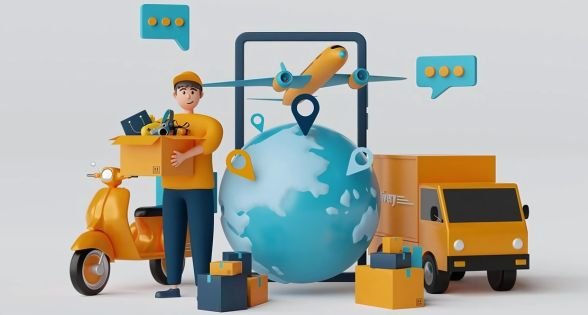E-commerce is growing fast, and customers now expect better service than ever. Last mile delivery is a big part of this change. It’s the final step in the delivery process, where products are sent from a local hub to a customer’s home. In 2025, last mile delivery is changing with new trends and challenges. Let’s look at what’s happening.
What is Last Mile Delivery?
Last mile delivery is the last step in the supply chain management. It moves goods from a local center to the customer. This step is crucial because it directly affects how happy customers are and how quickly they get their items. It’s also the most expensive and difficult part of the delivery process, so companies are always looking for better ways to manage it.
Last Mile Delivery in E-Commerce
In e-commerce, last mile delivery is very important. Shoppers want fast and reliable service, and businesses are working hard to provide same-day or next-day deliveries. To do this, they are using new technologies, smaller local warehouses, and flexible delivery plans. Good last mile delivery makes customers loyal and helps businesses stay ahead of their competition.
Key Trends Shaping Last Mile Delivery in 2025
Sustainability at the Forefront
People care more about the environment, so e-commerce companies are using green delivery methods. This includes electric vehicles, bicycles, and even drones. Urban areas now have smaller local warehouses to shorten delivery distances and cut emissions.
The Rise of Autonomous Delivery
Self-driving vehicles and robots are no longer just ideas. In 2025, companies like Amazon are using them to deliver packages. These technologies make deliveries faster and cheaper while helping solve worker shortages.
Hyper-Localization – Last Mile Delivery
Hyper-local delivery means setting up small warehouses close to where customers live. This helps businesses deliver faster and connect better with local communities.
Subscription-Based Delivery Models – Last Mile Delivery
Many companies now offer subscription plans where customers pay one fee for unlimited deliveries. This trend makes delivery costs predictable for shoppers and builds loyalty for businesses.
Dynamic Delivery Options
Customers want choices in how and when their packages arrive. Companies now offer features like tracking, scheduling deliveries, and using pickup points. These options make delivery more convenient and efficient.
Integration of AI and Data Analytics
Artificial intelligence helps companies plan routes, predict demand, and manage inventory. These tools make deliveries faster and cut costs while improving the customer experience.
Challenges in Last Mile Delivery
Even with improvements, last mile delivery still has problems. Solving these is key to keeping customers happy and operations smooth.
1. High Operational Costs
Last mile delivery is the most expensive part of the supply chain. The need for faster service drives up costs for labor, fuel, and technology. Finding ways to lower these costs while keeping quality high is a big challenge.
2. Urban Logistics Complexities
City deliveries face problems like traffic, limited parking, and strict rules. Businesses need creative solutions like bike couriers, delivery zones, or autonomous vehicles to handle these issues.
3. Customer Expectations
People want quick and fast deliveries. However, it’s hard for businesses to meet these demands without losing money. Companies need to balance speed and cost.
4. Scalability Issues
As online shopping grows, companies must handle more orders. Peak times, like holidays, are especially tough. Scaling up operations to meet demand is a challenge.
5. Data Privacy and Security
With more technology in delivery, protecting customer data is crucial. Businesses need to follow privacy laws and secure sensitive information to keep trust.
6. Workforce Challenges
Even with robots, delivery still needs workers. Shortages, high turnover, and the need for competitive wages make managing the workforce difficult. Training employees to use new tools is also important.
Strategies for Overcoming Last Mile Delivery Challenges
To solve these problems, e-commerce companies are trying new ideas. Here are some strategies:
1. Investing in Technology
Automation, robots, and AI help make deliveries faster and cheaper. For example, route optimization software helps delivery drivers save time and fuel.
2. Collaborative Logistics
Working with delivery partners or local couriers helps businesses expand their networks. This approach can also lower costs and improve service.
3. Flexible Delivery Models
Offering options like same-day, next-day, or scheduled delivery helps meet customer needs and manage resources better.
4. Sustainable Practices
Eco-friendly methods like electric vehicles and reusable packaging appeal to customers who care about the environment. These practices also improve a company’s reputation.
5. Focus on Customer Communication
Clear updates about deliveries make customers happy. Real-time tracking and notifications keep them informed and reduce complaints.
6. Scaling Infrastructure
Building more small warehouses and using better technology can help companies handle more orders during busy times.
Final Thought
In 2025, last mile delivery is about balancing new ideas with practical solutions. Trends like green delivery, AI, and robots are changing the game, but challenges like high costs and urban issues remain. Companies that adapt quickly will not only succeed but also set new standards for e-commerce.
By focusing on technology, sustainability, and customer needs, businesses can keep improving their last mile delivery. This will help them stay efficient, profitable, and ready for the future.
